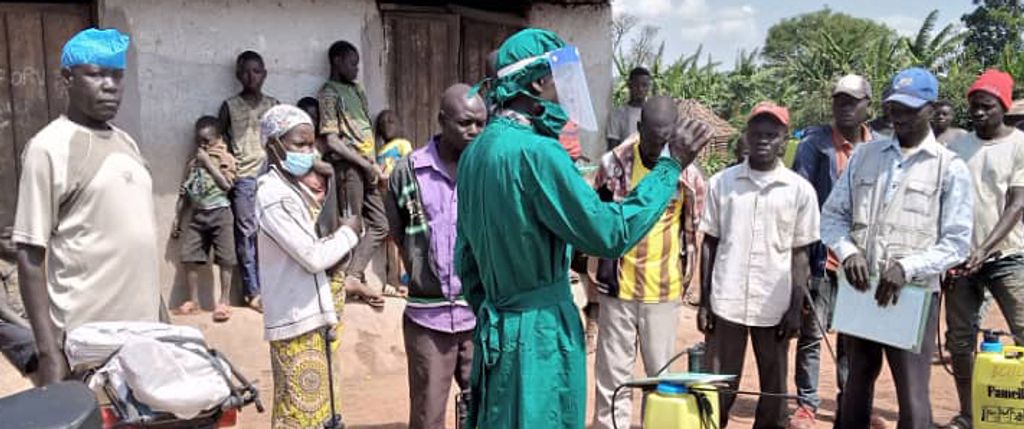
One Health in the DR Congo: Holistic epidemic prevention and control of tropical diseases
In the Democratic Republic of Congo (DR Congo), there are repeated outbreaks of zoonotic infectious and neglected tropical diseases (NTDs). Malteser International is therefore implementing One Health projects in two particularly affected regions. The aim is to consider human, animal and environmental health as a whole in order to improve healthcare and epidemic prevention in particularly vulnerable areas.
Since the end of 2021, we have been implementing a One Health project in the north-east of the country, in the Territoire de Mahagi, in the province of Ituri. Another cross-border project has been implemented since October 2021 in the north of the DR Congo, in the Territoire de Bondo in the province of Bas-Uélé, and in the south of the Central African Republic (CAR), in the Préfecture du Mbomou. Both project areas are home to numerous zoonotic infectious diseases and NTDs. In the Mahagi region, the One Health project supports the population in seven health zones (a total of around 1.7 million people) and in the Bondo region in three health zones and one health district in the CAR (a total of around 610,000 people). In addition, local health centers, veterinary facilities, villages, schools and public facilities in particular are supported.
The project areas in the provinces of Bas-Uélé and Ituri are regularly afflicted by zoonotic infectious diseases and NTDs. However, the disease outbreaks in the regions receive a relatively low level of attention and epidemiological data is rarely processed and analyzed.
The Territoire de Mahagi (Ituri province) borders Lake Albert to the southwest. Due to the body of water, the zoonosis schistosomiasis represents an increased risk factor in the region, which is transmitted through skin contact with cercariae - the smallest flukes - in the water. In addition, the Territoire de Mahagi is the only region in the DR Congo where zoonotic plague is endemic. Diseases such as rabies and brucellosis pose further risks.
In the project region in Bondo (Bas-Uélé province), a similar picture emerges with regard to the prevalence of zoonoses and NTDs. Additionally, a large part of the area is located in one of the largest nature reserves in the DR Congo (Bili-Uélé). The lush tropical region, changes in land use and the presence of various wild animals increase the risk of outbreaks of emerging infectious diseases. Local NTDs and zoonoses include e.g. river blindness, lymphatic filariasis, trachoma, schistosomiasis, Mpox and Ebola. Many diseases in the project region are specifically attributed to risky human-animal contact (e.g. through hunting) and a lack of food hygiene (particularly when handling meat).
Although these diseases originate in the human environment and especially in contact with the environment and animals, there is no exchange and coordination between the various stakeholders in human, animal and environmental health. In addition, effective early warning systems for zoonotic infectious diseases and NTDs are almost non-existent in both the human and veterinary sectors. Curative and preventive services are also limited or non-existent, e.g. due to a lack of financial and geographical access to medicines or inadequate laboratory diagnostics. On top of this, the population often lacks knowledge about the various infectious diseases, meaning that behavioral patterns are not adapted. Environmental factors such as a lack of access to safe drinking water, a lack of latrines and a lack of a waste disposal system are further factors that promote infectious diseases.
The One Health projects in the Mahagi and Bondo areas aim to contain the spread of zoonotic infectious diseases and NTDs through sustainable cross-sectoral strengthening of local capacities, thereby contributing to an improvement in human, animal and environmental health.
The aim of the projects is to reduce morbidity and mortality caused by zoonotic infections with epidemic potential and NTDs with serious effects on the health of the population through the multisectoral One Health approach.
The following sub-goals are pursued:
- Multisectoral One Health committees/task forces ensure scientific exchange and joint, coordinated action for the rapid containment of zoonoses and NTDs.
- Successful cooperation between civil society and government authorities in the public health, veterinary and education sectors in the prevention, curative treatment and diagnosis of local zoonotic diseases and NTDs.
- The population develops a multi-sectoral basic understanding of local zoonotic diseases, which leads to positive behavioral adaptations.
- Establishment of a cross-sectoral early warning system and joint reporting and collection of epidemiological data.
- Elimination of negative environmental influences, in particular by improving the WASH situation, contribute to the successful prevention of epidemics and malnutrition.
- Improving food security by reducing risky human-animal contact.
- Improving compliance with hunting and land use restrictions in protected areas.
Multisectoral coordination, knowledge generation and exchange:
- Establishment of multisectoral One Health committees/task forces incl. trained intervention teams
- Stakeholder workshops on the topic of One Health
- Implementation of prevalence studies for schistosomiasis and brucellosis as well as various KAP studies (e.g. on schistosomiasis, brucellosis, plague, rabies)
Awareness-raising measures and campaigns:
- Participatory education and communication campaigns e.g. on specific local zoonoses and NTDs, sanitation and hygiene behavior, food hygiene, dangers of hunting through risky human-animal contact, conservation & preservation of natural resources
- Introduction of teaching module on local zoonoses, NTDs, One Health in the Mahagi region
- Rabies vaccination campaign for domestic and stray dogs
- Mass distribution of praziquantel in areas around Lake Albert to treat and control the spread of schistosomiasis
Improving the diagnosis, curative treatment and prevention of local zoonoses and NTDs:
- Cross-sectoral training: e.g. training of veterinarians and health personnel in case definition, vaccination, laboratory technology
- Equipment for laboratories (microscopes, rapid tests, etc.)
- Partial assumption of costs for the treatment of zoonotic infectious diseases such as schistosomiasis and rabies (PrEP, PEP vaccinations)
- Establishment of cross-sectoral early warning systems for local zoonotic infections and NTDs as well as regular collection and evaluation of epidemiological data
Elimination of negative environmental impacts and improvement of WASH infrastructure:
- Construction of water systems and latrines
- Campaigns for waste disposal
- Construction of hygienic slaughterhouses and market stalls for fresh meat
Country info
Capital: Kinshasa
Area: 2,345,410 km²
Population: ca. 102.3 million
Project data
Donors: BMZ
Partners: CAAMENIHU, health authorities of the province and health zones, health centers and referral hospitals








